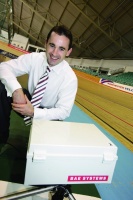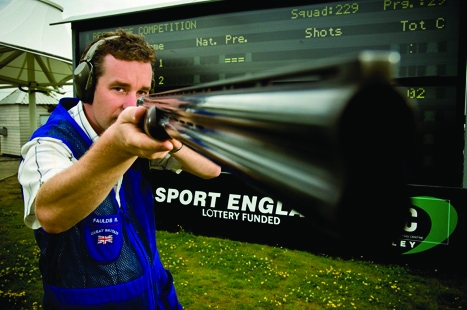
In the high-pressure world of elite sport, competitors need to find an edge over their opponents. Finding the best ways to improve performance during training sessions and in competition is often as much a race as the event itself. For the UK’s athletes, BAE Systems lends its engineering expertise to give a technological boost, through a partnership with UK Sport, the body that oversees the Olympic sports.
’UK Sport sits between all the various Olympic sports and ourselves - it has daily contact between all the teams and coaches and a very good understanding of the technical problems and issues they have,’ said Owen Evans, manager of the partnership; a former professional rugby player who joined BAE when injury put a halt to his sporting career.
’We have the expertise and skills to try to answer these questions within our businesses,’ he added. ’It’s my job to locate that capability and put together engineering teams to tackle these problems, monitoring the project from the initial concept all the way through to delivering a product.’
The form that product can take varies considerably. The best known is probably the skeleton bobsled on which Amy Williams slid to a gold medal in Vancouver in February, but Evans estimates that only half of the projects result in something that will itself be used in competition. The rest are training aids, many of which are designed to capture information about the athletes’ performance and relay it back to the coaches.
For example, one project ahead of the Beijing Olympics saw BAE’s engineers working with the shooting team on improving performances in double trap, an event where marksmen must shoot twice at two moving clay pigeon targets. ’They knew they needed some way of recording what they did in training, but they didn’t know what,’ Evans said.
The company sent in a team of engineers from its Advanced Technology Centre, who identified a direct correlation between the time between the first shot and the second, and the percentage of hits with the second shot. They devised a system with directional microphones and algorithms to detect the peak in the sound, while also filtering out background noise, which allowed them to detect which shooters were firing and the time they were taking between shots. Typically, the between-shot time was around 0.4 seconds, and previously the competitors and coaches could not find a way of timing this accurately.
’More importantly, that information is then relayed live to the coaches, so they can see the time difference and percentage hit ratio,’ Evans said. ’It’s the immediate feedback that enables sportspeople and coaches to react straight after a performance, and that’s what helps them to learn.’
Timing equipment also helped the all-conquering UK cycling team in Beijing, with a laser system, developed from battlespace identification, that can identify personal codes on reflective tags on the bike frames to time the cyclists to a millisecond accuracy - an improvement on the previous ’break-beam’ timing system.
The training aids capture information about performance and relay it back to the coaches
Other projects have concentrated on studying the performance of particular pieces of equipment used in specific sports. For example, a team looked at a new scoring vest for Taekwondo, which registers hits throughout the competition and tots up the points the fighter scored. The competitors needed to know how best to strike the vest; whether kicks or punches were more likely to score, where the hits were most likely to register, and how consistent the equipment was.

In the equipment area, BAE has worked with speed skaters to evaluate how the skates perform during a race, using strain gauges and data-logging equipment to watch the flexing of the metal blades during starts, cornering, sprinting and braking. The engineers devised titanium brackets to align the blades, making the skate lighter and increasing its stiffness and stability.
The team is also working with Paralympic wheelchair athletes, using a wind tunnel to refine the design of their racing wheelchairs to reduce their weight and cut drag. ’We try to involve the sportspeople as much as possible - they have so much information that’s useful for us,’ Evans said.
’We try to invite them to every meeting, because ultimately, we’re designing something that’s just for them.’
Projects evolve in a number of ways, Evans explained. Sometimes, UK Sport will come to BAE with a problem where there is no clue as to what the solution might be; in others - such as the skeleton bob - the goal of the project is apparent from the start.
There is no permanent team working on sporting engineering at BAE; instead, a specific team is put together for each problem. ’We second people in from the various units depending on what’s needed,’ Evans said. ’Sometimes they’ll work on the project alongside their usual work, and sometimes we’ll set up a full-time team.’
In general, people enjoy working on the sporting projects. ’One of the reasons BAE got involved was to energise and reward staff with these very interesting, diverse projects,’ Evans explained. ’There’s such a direct correlation between the appliance of technology and sporting performance, so any engineering team I approach always jumps at the chance to get involved, because they know it can make a big difference. Everyone likes to have the opportunity to contribute so directly to winning a gold medal.’
Owen Evans Biography
Manager of technology partnership with UK Sport at BAE Systems
Education
2000 University of Bath - degree in biological sciences and Masters in business and management
Athletics
1998 Bronze medal at GB Youth Indoor Championships, 100m (representing Wales)
Rugby
1998 Wales Schoolboys
2003-2005 England Students
2001 Signed for Bristol Shoguns - won Powergen Shield 2005
2006 Signed for Taranaki (New Zealand) - won Grand Final 2006
Working career
2007 Joined BAE Systems
2008 Appointed manager of UK Sport technology partnership
Q&A Engineering victory
How do you involve academia in your projects?
There are a number of ways -the skeleton bob project was a prime example. It was a collaborative partnership between ourselves, the sports science departments at the University of Southampton and Loughborough University and UK Sport, and we actually took on the secondment of PhD students to our Advanced Technology Centre. That meant we could accelerate the programme forward, and also allowed great transfer of skills: sports-focused skills from the universities, and rigorous, industrial engineering skills in the other direction. Our Military Air Solutions division in Wharton also has a direct link with Loughborough University, and we’ve become involved in projects via that as well.
How does the relationship between this research and the sport governing bodies work?
We have to work very closely. Again, looking at the skeleton bob as an example, there are very closely defined rules about what you can slide on, and your sled is inspected before each competition. We work with the governing bodies at every opportunity to make sure we’re within specification.
Do similar strictures apply to training aids?
No. For them, it’s a case of whatever goes - you can train however you want. The performances and the data from that training belongs to you, so if you can record them and learn from them, and increase your performance from that, it is your prerogative. The Research and Innovation Department of UK Sport tries to identify every way it can capture any bit of data it can, because it is the best way to identify how to improve performances.
Is there an ethical dimension to this? Do you think there’s a problem with giving athletes an unfair advantage?
As far as we’re concerned, there’s absolutely no ethical debate about it. Every country is playing by the same rules, and the way I look at it, athletes such as Chris Hoy and Victoria Pendleton have trained their entire lives for these events, they’ve waited so long. Putting them on the start line against other countries who are also trying to push the boundaries in the same way that we are would be extremely unprofessional of UK Sport and ourselves. We have to give them the best preparation and the best technology to try to prove themselves out there.




Swiss geoengineering start-up targets methane removal
No mention whatsoever about the effect of increased methane levels/iron chloride in the ocean on the pH and chemical properties of the ocean - are we...